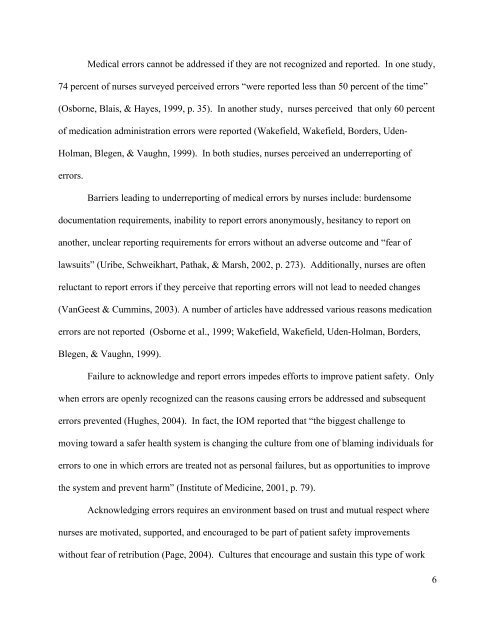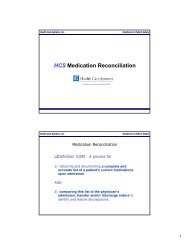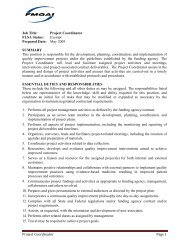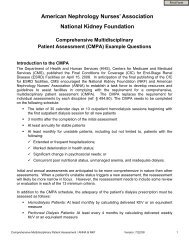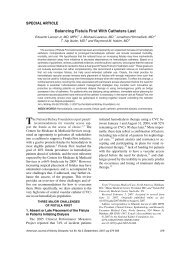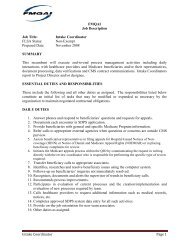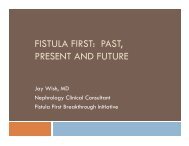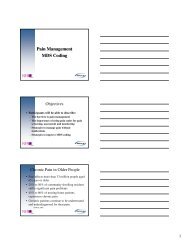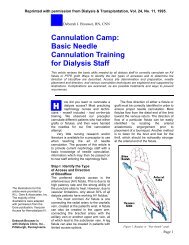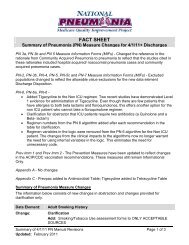The Nurse's Role in Promoting a Culture of Patient Safety - FMQAI
The Nurse's Role in Promoting a Culture of Patient Safety - FMQAI
The Nurse's Role in Promoting a Culture of Patient Safety - FMQAI
You also want an ePaper? Increase the reach of your titles
YUMPU automatically turns print PDFs into web optimized ePapers that Google loves.
Medical errors cannot be addressed if they are not recognized and reported. In one study,<br />
74 percent <strong>of</strong> nurses surveyed perceived errors “were reported less than 50 percent <strong>of</strong> the time”<br />
(Osborne, Blais, & Hayes, 1999, p. 35). In another study, nurses perceived that only 60 percent<br />
<strong>of</strong> medication adm<strong>in</strong>istration errors were reported (Wakefield, Wakefield, Borders, Uden-<br />
Holman, Blegen, & Vaughn, 1999). In both studies, nurses perceived an underreport<strong>in</strong>g <strong>of</strong><br />
errors.<br />
Barriers lead<strong>in</strong>g to underreport<strong>in</strong>g <strong>of</strong> medical errors by nurses <strong>in</strong>clude: burdensome<br />
documentation requirements, <strong>in</strong>ability to report errors anonymously, hesitancy to report on<br />
another, unclear report<strong>in</strong>g requirements for errors without an adverse outcome and “fear <strong>of</strong><br />
lawsuits” (Uribe, Schweikhart, Pathak, & Marsh, 2002, p. 273). Additionally, nurses are <strong>of</strong>ten<br />
reluctant to report errors if they perceive that report<strong>in</strong>g errors will not lead to needed changes<br />
(VanGeest & Cumm<strong>in</strong>s, 2003). A number <strong>of</strong> articles have addressed various reasons medication<br />
errors are not reported (Osborne et al., 1999; Wakefield, Wakefield, Uden-Holman, Borders,<br />
Blegen, & Vaughn, 1999).<br />
Failure to acknowledge and report errors impedes efforts to improve patient safety. Only<br />
when errors are openly recognized can the reasons caus<strong>in</strong>g errors be addressed and subsequent<br />
errors prevented (Hughes, 2004). In fact, the IOM reported that “the biggest challenge to<br />
mov<strong>in</strong>g toward a safer health system is chang<strong>in</strong>g the culture from one <strong>of</strong> blam<strong>in</strong>g <strong>in</strong>dividuals for<br />
errors to one <strong>in</strong> which errors are treated not as personal failures, but as opportunities to improve<br />
the system and prevent harm” (Institute <strong>of</strong> Medic<strong>in</strong>e, 2001, p. 79).<br />
Acknowledg<strong>in</strong>g errors requires an environment based on trust and mutual respect where<br />
nurses are motivated, supported, and encouraged to be part <strong>of</strong> patient safety improvements<br />
without fear <strong>of</strong> retribution (Page, 2004). <strong>Culture</strong>s that encourage and susta<strong>in</strong> this type <strong>of</strong> work<br />
6


